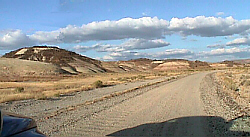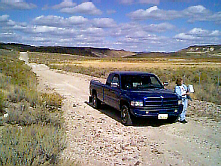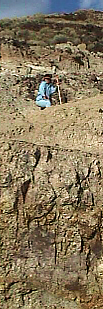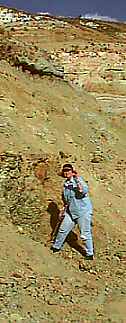Denio, Nevada
Digging in an Opal Mine
in Virgin Valley
October 3rd, 1998
 While
staying in Winnemucca, Laura was perusing a copy of the Nevada
Bonus Book she had picked up at the last visitor’s center.
She found an article on digging for opals along the Nevada Oregon
border in a small town called Denio. We decided to check it out.
The next morning we traveled north out of Winnemucca, Nevada, for
an hour until we reached the Oregon border, at the little town of
Denio. We were looking for an opal mine, but found nothing. Denio
is a point on the border. Three trailers and a bar. We went into
the bar. It’s is an interesting feeling going into a local
bar where there are no outsiders. The squeaky door opened and
Laura stepped in. Every head in the bar, all 6 of them,
simultaneously turned in rhythm toward her. All conversation
stopped and suddenly the noise for the two slot machines seemed
to be the only sound. After several seconds of expressionless
staring , all heads turned back with the same simultaneous motion
and as if on cue, low conversations started from both sides of
the room.
While
staying in Winnemucca, Laura was perusing a copy of the Nevada
Bonus Book she had picked up at the last visitor’s center.
She found an article on digging for opals along the Nevada Oregon
border in a small town called Denio. We decided to check it out.
The next morning we traveled north out of Winnemucca, Nevada, for
an hour until we reached the Oregon border, at the little town of
Denio. We were looking for an opal mine, but found nothing. Denio
is a point on the border. Three trailers and a bar. We went into
the bar. It’s is an interesting feeling going into a local
bar where there are no outsiders. The squeaky door opened and
Laura stepped in. Every head in the bar, all 6 of them,
simultaneously turned in rhythm toward her. All conversation
stopped and suddenly the noise for the two slot machines seemed
to be the only sound. After several seconds of expressionless
staring , all heads turned back with the same simultaneous motion
and as if on cue, low conversations started from both sides of
the room.  We
walked to the far end of the bar and inquired about the Royal
Peacock Opal Mine. Silence, then the bar maid said “Back
about 3 miles take the road to the right. Hey Hank how far are
the mines?” This evoked a multitude of comments and a
discussion on distance commenced. The consensus was 30 miles. We
bought an ice tea in appreciation and headed back to the cut-off.
Some 30 minutes later, having avoided the loose cattle and a wild
burro which crossed in front of us, we arrived at a small sign,
next to a gravel road declaring the that the Royal Peacock Opal
Mine was ten miles down that dusty trail.
We
walked to the far end of the bar and inquired about the Royal
Peacock Opal Mine. Silence, then the bar maid said “Back
about 3 miles take the road to the right. Hey Hank how far are
the mines?” This evoked a multitude of comments and a
discussion on distance commenced. The consensus was 30 miles. We
bought an ice tea in appreciation and headed back to the cut-off.
Some 30 minutes later, having avoided the loose cattle and a wild
burro which crossed in front of us, we arrived at a small sign,
next to a gravel road declaring the that the Royal Peacock Opal
Mine was ten miles down that dusty trail.  After about 8 miles of wash board driving we
stopped to consult the map. As we suspected our mapping program
indicated that we were in the middle of a desert where there were
no official roads. On we traveled, finally arriving at a single
house with outbuildings painted a soft yellow. The lady was quite
nice, took our $20, and handing Laura a rake she had us
follow her even deeper into the hills until we came to a strip
mining operation. Laura went right at it and for the next 4 hour
hours raked, kicked, picked,
After about 8 miles of wash board driving we
stopped to consult the map. As we suspected our mapping program
indicated that we were in the middle of a desert where there were
no official roads. On we traveled, finally arriving at a single
house with outbuildings painted a soft yellow. The lady was quite
nice, took our $20, and handing Laura a rake she had us
follow her even deeper into the hills until we came to a strip
mining operation. Laura went right at it and for the next 4 hour
hours raked, kicked, picked,  and examined clumps of clay and pieces of
petrified wood until with a gleeful shout she held up the first
of three pieces she would find, each containing the elusive opal.
While she was digging, I read the small information sheet that
came with the fee. It
seems that nearly 14 million years ago the area which is now
known as the Virgin
and examined clumps of clay and pieces of
petrified wood until with a gleeful shout she held up the first
of three pieces she would find, each containing the elusive opal.
While she was digging, I read the small information sheet that
came with the fee. It
seems that nearly 14 million years ago the area which is now
known as the Virgin Valley, in the northwest corner of the
Humboldt mountain country, was covered by lakes and forest. Today
what we see are simply bare hills. The entire area was several
thousand feet lower and more like the coastal mountains ranges of
today. However the earth was not quiet. Volcanoes periodically
erupted, blasting the forests apart and burying them under
hundreds of feet of ash. This cycle was repeated many times over
the next million years. Magma later pushed to the surface and
repeatedly flowed over the region. When the Earth quit shaking,
the layers of ash and blasted trees were buried more then 1500
feet deep. Under millions of tons of rock and ash, one of the
miracles of nature was taking place, transforming common silica
into Fire Opal. The pieces of the burned forest were
disintegrating and the ash surrounding them was compressed into
clay. From deep underground, super-heated water flowed upward
through the cracks and faults in the silica rich ash layers.
Valley, in the northwest corner of the
Humboldt mountain country, was covered by lakes and forest. Today
what we see are simply bare hills. The entire area was several
thousand feet lower and more like the coastal mountains ranges of
today. However the earth was not quiet. Volcanoes periodically
erupted, blasting the forests apart and burying them under
hundreds of feet of ash. This cycle was repeated many times over
the next million years. Magma later pushed to the surface and
repeatedly flowed over the region. When the Earth quit shaking,
the layers of ash and blasted trees were buried more then 1500
feet deep. Under millions of tons of rock and ash, one of the
miracles of nature was taking place, transforming common silica
into Fire Opal. The pieces of the burned forest were
disintegrating and the ash surrounding them was compressed into
clay. From deep underground, super-heated water flowed upward
through the cracks and faults in the silica rich ash layers.  Current thought on how opals are
created is that as the super-heated water moved through the ash
layers, it dissolved some of the silica from the ash. When the
water encountered a cavity left by the disintegrated wood, the
water slowed, allowing some of the dissolved silica to be
deposited. Over the centuries, this process was repeated again
and again, forming opals in the cavities left by the decaying
wood. It was in these pockets along with petrified wood that
Laura found her price. It was quite an interesting adventure.
Just one day in the lives of a couple of adventurers.
Current thought on how opals are
created is that as the super-heated water moved through the ash
layers, it dissolved some of the silica from the ash. When the
water encountered a cavity left by the disintegrated wood, the
water slowed, allowing some of the dissolved silica to be
deposited. Over the centuries, this process was repeated again
and again, forming opals in the cavities left by the decaying
wood. It was in these pockets along with petrified wood that
Laura found her price. It was quite an interesting adventure.
Just one day in the lives of a couple of adventurers.
*** THE END ***
